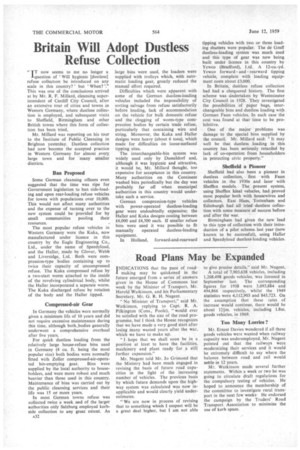Britain Will Adopt Dustless Refuse Collection
Page 34

If you've noticed an error in this article please click here to report it so we can fix it.
" TT now seems to me no longer a iquestion of Will hygienic [dustless] refuse collection be introduced on any scale in this country?' but When? '." This was one of the conclusions arrived at by Mr. R. F. Millard, cleansing superintendent of Cardiff City Council, after an extensive tour of cities and towns in Western Germany, where dustless collection is employed, and subsequent visits to Sheffield, Birmingham and other British towns where this form of collection has been tried.
Mr. Millard was reporting on his tour to the Institute of Public Cleansing in Brighton yesterday. Dustless collection had now become the accepted practice in Western Germany for almost every large town and for 'many smaller districts.
Ban Proposed
Some German cleansing officers even suggested that the time was ripe for Government legislation to ban side-loading and open rear-loading refuse vehicles for towns with populations over 10,000. This would not affect many authorities and the expense of turning over to the new system could be provided for by small communities pooling their resources.
The most popular refuse vehicles in Western Germany were the Kuka, now manufactured under licence in this country by the Eagle Engineering Co., Ltd., under the name of Speedyload, and the Haller, made by Glover, Webb and Liversidge, Ltd. Both were compression-type bodies containing up to twice their capacity of uncompressed refuse. The Kuka compressed refuse by a two-start worm attached to the inside of the revolving cylindrical body, whilst the Haller incorporated a separate worm. The Kuka discharged refuse by rotation of the body and the Haller tipped.
Compressed-air Gear In Germany the vehicles were normally given a minimum life of 10 years and did not require excessive maintenance during this time, although both‘bodies generally underwent a comprehensive overhaul after five years.
For quick dustless loading from the relatively large house-refuse bins used in Germany (4 Cu. ft. being the most popular size) both bodies were normally fitted with Zoller compressed-air-operated bin-emptying gear. Bins were supplied by the local authority to householders, and were more robust and much heavier than those used in this country. Maintenance of bins was carried out by the public cleansing services and their life was 15 or more years.
In most German towns refuse was collected twice a week and of the larger authorities only Salzburg employed kerbside collection to any great extent. As A32 large bins were used, the loaders were supplied with trolleys which, with automatic loading gear, greatly reduced the manual effort required.
Difficulties which were apparent with some of the German dustless-loading vehicles included the impossibility of sorting salvage from refuse satisfactorily before loading, lack of accommodation on the vehicle for bulk domestic refuse and the clogging of worm-type compression bodies by certain trade refuse, particularly that containing wire and string. Moreover, the Kuka and Haller designs were heavy (about 6 tons), which made for difficulties on loose-surfaced tipping sites.
The interchangeable-bin system was widely used only by Dusseldorf and, although it was hygienic and attractive, it would be, Mr. Millard thought, too expensive for acceptance in this country. Many authorities on the Continent washed bins periodically but the day was probably far off when municipal authorities in this country would undertake such a service.
German compression-type vehicles with power-operated dustless-loading gear were undoubtedly expensive; the Haller and Kuka designs costing between £4,000 and E4,500 each. If smaller refuse bins were used it was possible to fit manually operated dustless-loading equipment.
In Holland, forward-and-rearward
tipping vehicles with two or three loading shutters were popular. The de Graff dustless-loading system was much used and this type of gear was now being built under licence in this country by Yewco (Bradford), Ltd. A 12-cu.-yd. Yewco forward and rearward tipping vehicle, complete with loading equipment costs about £3,000.
In Britain, duStless refuse collection had had a chequered history. The first scheme was undertaken by Westminster City Council in 1928. They investigated the possibilities of paper bags, interchangeable bins and dustless loading with German Faun vehicles. In each case the cost was found at that time to be prohibitive.
One of the major problems was damage to the special bins supplied by the council. Mr. Millard said: "It may well be that dustless loading in this country has been seriously retarded by lack of co-operation from householders in protecting civic property."
Sheffield a Pioneer
Sheffield had also been a pioneer in dustless collection, first with Faun vehicles in the 1930s and later with Sheffiex models. The present system, using Shefflex Ideal vehicles, had proved most popular both with housewives and collectors. East Ham, Tottenham and Edinburgh had all tried dustless collection with some measure of success before and after the war.
Birmingham had given the new lead to this type of collection with their introduction of a pilot scheme last year (now known to be successful), using Haller and Speedyload dustless-loading vehicles.




















































































